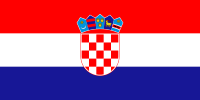 Croatia (pronounced /kroʊˈeɪʃə/, kroe-AY-shə; Croatian: Hrvatska pronounced [xř̩ʋaːtskaː]), officially the Republic of Croatia (Croatian: Republika Hrvatska), is a country in Central Europe andSoutheastern Europe at the crossroads of the Pannonian Plain, the Balkans, and the Adriatic Sea. Its capitaland largest city is Zagreb. Croatia borders Slovenia to the north, Hungary to the northeast, Bosnia and Herzegovina to the southeast, Serbia to the east, and Montenegro to the southeast.
Croatia (pronounced /kroʊˈeɪʃə/, kroe-AY-shə; Croatian: Hrvatska pronounced [xř̩ʋaːtskaː]), officially the Republic of Croatia (Croatian: Republika Hrvatska), is a country in Central Europe andSoutheastern Europe at the crossroads of the Pannonian Plain, the Balkans, and the Adriatic Sea. Its capitaland largest city is Zagreb. Croatia borders Slovenia to the north, Hungary to the northeast, Bosnia and Herzegovina to the southeast, Serbia to the east, and Montenegro to the southeast.
The Croats arrived in the early seventh century in what today is Croatia. They organized the state into two dukedoms. The first king, King Tomislav was crowned in AD 925 and Croatia was elevated into the status of a kingdom. The Kingdom of Croatia retained its sovereignty for almost two centuries, reaching its peak during the rule of Kings Peter Krešimir IV and Demetrius Zvonimir. Croatia entered a union with Hungary in 1102. In 1526, the Croatian Parliament elected Ferdinand from the House of Habsburg to the Croatian throne. In 1918, Croatia declared independence from Austria–Hungary and co-founded the Kingdom of Yugoslavia. An independent Croatian state briefly existed during World War II. After World War II, Croatia became a founding member of the Second Yugoslavia. On 25 June 1991, Croatia declared independence and became a sovereign state.
Croatia is a member of the United Nations, the Council of Europe, NATO, the World Trade Organization and CEFTA. The country is a candidate for European Union membership and is a founding member of the Union for the Mediterranean. Croatia is classified as an emerging and developing economy by the International Monetary Fund and a high income economy by the World Bank.
Croatian culture is the result of a fourteen century-long history which has seen the development of many cities and monuments and also includes many adoptions from ancient Greek, Roman and Illyrian cultures. The country includes seven World Heritage sites and eight national parks. Croatia is also the birthplace of a number of historical figures. Included among the notable people are three Nobel prize winners and numerous inventors. The country is also rich with Intangible culture and holds the largest number of UNESCO’s World’s intangible culture masterpieces inEurope.
Some of the world’s first fountain pens came from Croatia. Croatia also has a place in the history of clothing as the origin of the necktie (kravata). The country has a long artistic, literary and musical tradition. Also of interest is the diverse nature of Croatian cuisine and the famous Croatian Traditional gift Licitar.
Wheat and other grains, sugar beets, sunflower seeds, alfalfa, clover, olives, citrus, grapes, and soybeans are grown; dairying, beekeeping, and fishing are also important. More than one third of the country is forested, and lumber is a major export. Croatia is, excepting Slovenia, the most industrialized and prosperous of the former republics of Yugoslavia. There are oil fields and deposits of bauxite, iron ore, and other minerals. Shipbuilding, petroleum refining, and food processing are important; chief manufacturers include chemicals, plastics, machine tools, fabricated metal, electronics, iron and steel, aluminum, paper, wood products, and textiles.
Tourism, especially along the Adriatic coast, is also important to the economy. Severely curtailed during the warfare of the early 1990s, the tourist trade had largely recovered by 2000. Transportation equipment, textiles, chemicals, foodstuffs, and fuels are exported, while machinery, electrical equipment, chemicals, and fuels are imported. The main trading partners are Italy, Germany, Slovenia, and Bosnia and Herzegovina.
Notes from Wikipedia and Answers.com









